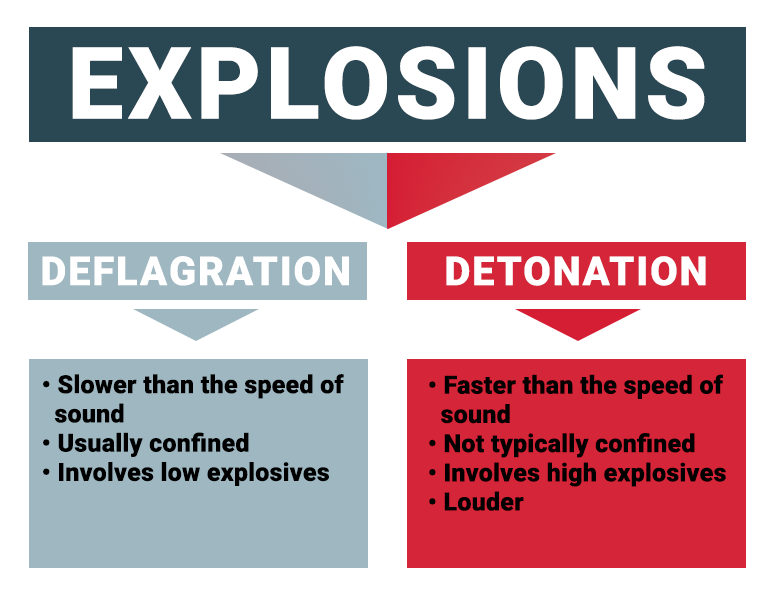When it comes to things that go boom, terms such as explosion, deflagration, and detonation are often incorrectly used interchangeably. To help clear things up, this blog will go into the technical definitions of explosions, deflagrations, and detonations, as well as the appropriate time to use each term.

Explosion
An explosion is a sudden, rapid release of energy that produces potentially damaging pressures.
When a gaseous fuel fills a space, it needs to mix to a certain air-fuel concentration to create an explosive atmosphere. When an ignition source is introduced into the explosive atmosphere, it creates a flame that travels away from the ignition site and expands the burned gases behind the flame front. When an explosion is confined, it creates a restraint of the expanding gases and results in an increased pressure within the enclosure. When the enclosure ruptures, this is what most people think of when they hear the term explosion. However, explosions don’t always need to be confined. The flame speed in explosions can be quick enough to produce compression waves and cause damage with little or no confinement.
The damage potential of an explosion depends on the pressure that is created from the explosion as well as how quickly energy is released from the explosion. Explosions can be either detonations or deflagrations depending on their flame speed.
Explosion A sudden, rapid release of energy that produces potentially damaging pressures. Deflagrations and detonations are types of explosions.
Deflagration
A deflagration is an explosion where the flame speed is lower than the speed of sound, which is approximately equal to 335 m/sec (750 mph).
Explosives that deflagrate are known as low explosives. The actual speed of the explosion can vary from 1–350 m/s (2–780 mph). Peak pressures produced by low explosives are orders of magnitude lower than those produced by high explosives, and the damage inflicted by low explosives can vary greatly depending on the fuel and confinement. For example, if black powder is ignited outside of containment, it just fizzles, but when it is confined, it creates an explosion that can propel bullets.
Deflagration An explosion where the flame front travels through the air-fuel mixture slower than the speed of sound
In addition to the black powder example, examples of deflagrations involving low explosives include the ignition of propane gas for a cooking grill and fuel powering of a combustion engine in a car.
Detonation
A detonation is an explosion where the flame speed is greater than the speed of sound.
Detonations are louder and often more destructive than deflagrations. While deflagration occurs when a fuel and oxidizer (typically air) mix, a detonation doesn’t always need an external oxidizer. Explosives that detonate are referred to as high explosives and have a detonation speed in the range of 2,000–8,200 m/sec (4,500–18,000 mph). High explosives are typically designed to cause destruction—often for demolition, mining, or warfare.
Detonation An explosion where the flame front travels through the air-fuel mixture faster than the speed of sound
Examples of high explosives that detonate include dynamite, TNT, and C4, a plastic-based explosive.
Learn more
Hopefully, this blog helped shed some light on these common terms you hear when discussing types of explosions. For more information on explosions, check out the 21st edition of the NFPA Fire Protection Handbook®, which contains several chapters on the topic, including Chapter 2-8, “Explosions,” Chapter 6-16, “Explosives and Blasting Agents,” Chapter 17-8, “Explosion Prevention and Protection,” and Chapter 18-6, “Deflagration Venting.”
The following codes and standards are also related to explosions:
NFPA 495, Explosive Materials Code
NFPA 69, Standard on Explosion Prevention Systems
NFPA 68, Standard on Explosion Protection by Deflagration Venting
NFPA 67, Guide on Explosion Protection for Gaseous Mixtures in Pipe Systems
Important Notice: Any opinion expressed in this column (blog, article) is the opinion of the author and does not necessarily represent the official position of NFPA or its Technical Committees. In addition, this piece is neither intended, nor should it be relied upon, to provide professional consultation or services.
The post "Explosions, Deflagrations, and Detonations" appeared first on NFPA Today Blogs






0 Comments